Ho Chi Minh City, also known as Saigon, is the biggest metropolis in Vietnam. Once the Pearl of Indochina, Saigon is nowadays a bustling city where the past meets the present, where the nostalgia nestles quietly beside the dynamic vibe of Vietnam’s most developing city. Taking a glimpse at Saigon buildings is a great way to learn more about this city. From the oriental houses to French colonials buildings to the modern skyscrapers, the architecture of Saigon is definitely a thing that you should not forget to explore.
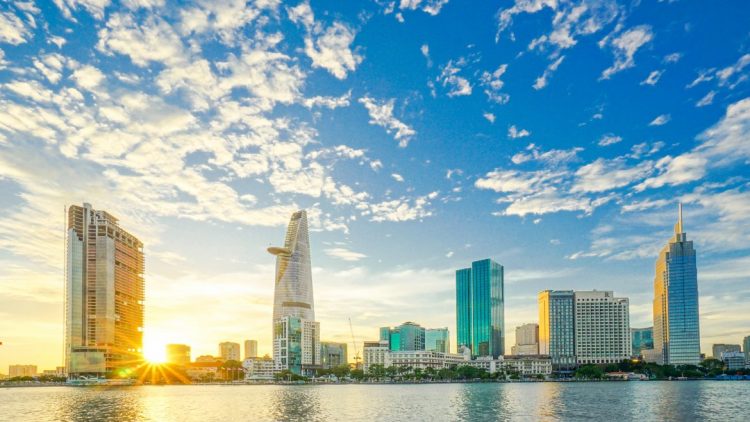
Source: Lux Travel DMC
I. A glimpse at the development of Saigon architecture via history.
The town of Saigon has long been a hub of cultures and economy; hence, it is explainable that this city is where cultures meet. Not only carrying their customs and norms, but people from different parts of the world gathering there also bring along their signature architecture design. Varying styles of houses and buildings, as a result, have appeared across the city.
In its early days, Saigon used to be similar to other Vietnamese regions. Wood, bricks, plasters, and tiles are the major materials that formed Saigon houses. It was not until the early 20th century that building materials from different countries were imported and the blends between Vietnamese classical styles and Western elements existed.
1. Saigon buildings bear a strong Western architecture vibe
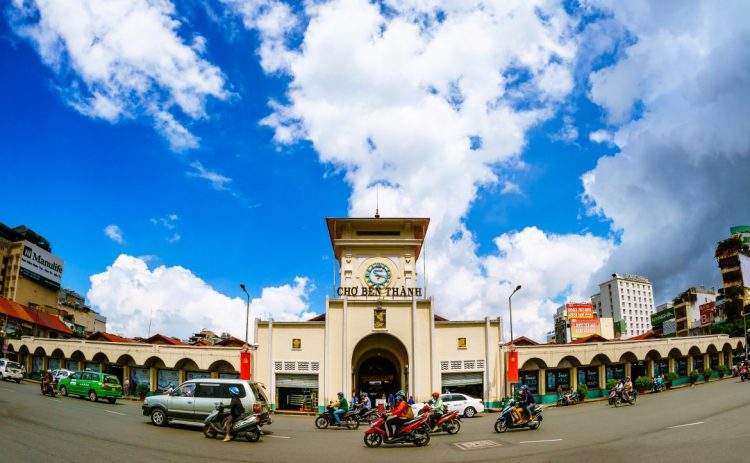
Source: Lux Travel DMC
At that time, Saigon buildings were uniformed in terms of height and styles. A house tended to have 3 floors. The first floor was the tallest to tap Vietnamese thinking of “Nha Cao Cua Rong” (high ceiling and wild gate). It often served business activities. The two higher floors had lower ceilings and were where the families lived. Interestingly, the houses on the same blocks would have the same height, thus looking exceptionally aesthetic.
Typical Saigon buildings at that period often had red roof tiles, light turquoise wooden louvered windows, and Indochina-style balustrade, which were quite sophisticated yet elegant and graceful.
2. The influences of Chinese architecture
Aside from Western influences, Chinese elements also exist in the buildings in Saigon in the past century. You can feel the Chinese vibe when reaching the Cho Lon area, which is in District 4 & 5 nowadays.
Funny thing is, two parts of Cho Lon are home to different styles. In the place where Chinese people from Guangzhou immigrated to, their houses followed the traditional neoclassical architecture of their home city. In the other part, where people came from HongKong and Singapore – the once English colonies, the modern vibe was more clear.
3. Saigon Buildings nowadays
Time flies and Ho Chi Minh City still keeps rocketing. The fast development pace has entailed new high buildings and skyscrapers all across the city. By the end of 2018, Saigon ranks second (following Hanoi) in the number of sky buildings with 799 buildings that are higher than 200m. Most of these high buildings concentrate in the riverside districts like District 1, 2, 4, 7, and Binh Thanh District.
The highest skyscrapers in Saigon today is Landmark 81, which is 461.3 m (1,513 ft) high. This is also the highest in Vietnam and the 14th highest buildings in the world.
II. Iconic Saigon buildings of the 21st century.
As mentioned above, the city possesses nearly 800 towers that reach and exceed 200 meters. These Saigon buildings might be the office towers, apartments, the shopping malls, or the combination of these. Even though more and more high-rise buildings are being or about to be constructed, in Saigoners’ minds, the Bitexco Financial Tower and Landmark 81 are always the landmarks of the city.
1. Bitexco Financial Tower – once the landmark of Saigon
Since 2010, Bitexco Financial Tower had been the most famous skyscraper in HCMC for years until it was surpassed by the higher Landmark 81 in 2018. It used to be the tallest buildings in HCMC with a height of 262 meters. Consisting of 68 floors, this tower houses the Ho Chi Minh City office of Bitexco Real Estate Group and serves as the office tower for several domestic and multinational enterprises.

Source: Lux Travel DMC
Bitexco Tower is the pride of Saigon architecture thanks to its spectacular design. The tower resembles the shape of a lotus flower – the National Flower of Vietnam. Especially, on the 52nd story of the buildings exist a helipad, which is the first non-rooftop landing area for helicopters in Vietnam.
The tower is open to tourists who come to admire the city’s beauty. On the 49th floor of this building locates an observation deck called Saigon Skydeck, from which people can catch a 360° view of the splendid Saigon. You can then head up to the EON bar, restaurant, and cafe on the 50th – 52nd floors for an afternoon tea party while enjoying the majestic skyline outside the window.
Possessing excellent architecture, Bitexco has won several awards ever since it was still on the paper. In 2011, the building was honored with the Excellence in Structural Engineering Awards for international structure valuing more than 100 million USD. 2 years later, it was named by CNN as one of the World’s 25 Great Skyscraper Icons of Construction. It was also voted to be the 2nd Coolest Skyscraper in the world by Thrillist.com in 2015.
2. Landmark 81 – the tallest among Saigon Buildings
Since 2018, Landmark 81 has taken the crown of Keangnam Hanoi Landmark Tower (349 meters tall) to become the tallest buildings in Vietnam. This Vietnamese architectural work is also the tallest in Southeast Asia (by July 2018) and ranks 14th in the list of high-rise buildings all over the world.
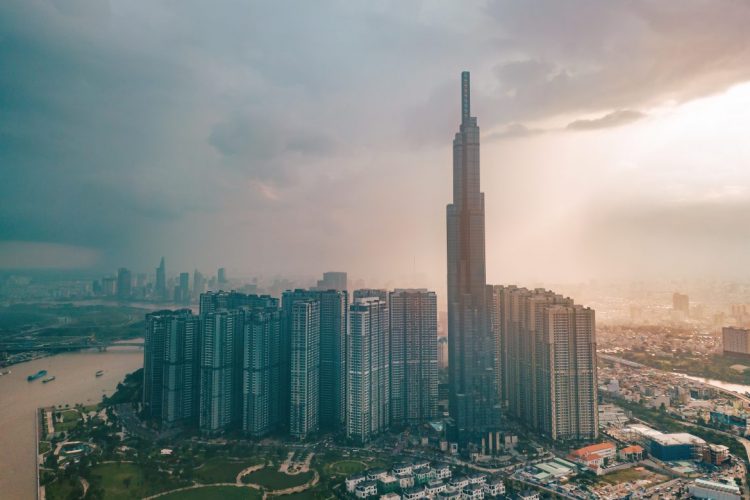
Source: Unsplash – Tron Le
Landmark 81 belongs to Vingroup’s Vinhomes – the country’s biggest real estate corporation that owns many high-end Saigon buildings. Surprisingly, this mega project is conducted by a Vietnamese bidder called Coteccons, who won huge international competitors like Lotte and SsangYong to become the main contractor of Landmark 81. In other words, this high-rise is “authentically” Vietnamese.
This skyscraper is 461.15 meters high, consists of 81 floors, and has a prime location. It is situated on the western riverside of Saigon River in Binh Thanh District and is the center of Vinhomes Central Park – a luxurious mix-used area developed by the same investor. Landmark 81 houses a luxury hotel, high-end apartments, opulent shopping centers, bars & restaurants, and an observation deck. This is the result of the ideas and designs from the worldwide famous designers, consultants, and contractors who have contributed to the fame of the reputable buildings like Sydney’s Opera House, Shanghai’s Lotus Hotel, and Arab Saudi’s Bahrain World Trade Center.
The inspiration for Landmark 81 comes from bamboo – the familiar image that has accompanied the nation ever since the very first days, witnessing the establishment, expansion, and defense against the outside invaders. Resembling the bamboo clump, Vinhomes’ Landmark 81 showcases the unity, stability, and non-stop development of the country. Thus, it is undeniably the nation’s pride in architectural design.

Source: Unsplash – Tron Le
Among Saigon buildings, this skyscraper offers the most impressive observation deck. Its observation area is located on 3 stories from No. 79 to No. 81, providing a panoramic bird’s eye view over the dynamic Ho Chi Minh City. Notably, the deck is equipped with microscopes and touch screens so that viewers can catch the clearest city view.
Inside the building also locates first-class elite clubs where only desirable guests can get exclusive access. Extravagant wine and cigar lounge are situated at the top bar to offer you the most elegant and lavish moments. Besides these exquisite facilities, visitors coming to Landmark 81 can also relax in the 14-hectare-wide Central Park – the largest riverside park in HCMC.
III. Top ancient and old Saigon buildings
1. Saigon Opera House
The Municipal Theatre, better known as Saigon Opera House, is the first to be mentioned in the list of most outstanding Saigon buildings during the French colonial period. Together with the bigger counterpart – Hanoi Opera House, this building is a typical example of Beaux-Arts architecture – the neoclassical style that was popular in Paris in the 19th and 20th century.
During the war, this 500-seat building worked as the seat of the Lower House Assembly of Saigon Government. After 1975, it turned back to be a theatre and then underwent a restoration in 1998.
Nowadays, the Saigon Opera House is an appealing destination for art lovers. It is the venue for various art performances, namely A O Show – a must-see cultural show for any Saigon tours.
2. Independence Palace
Also known as the Reunification Hall, the Independence Palace is an architectural work that represents the historical values of Ho Chi Minh City. The palace was built in 1962 and used to be the home and the workplace of Southern Vietnam Governors during the Vietnam War. During the Fall of Saigon, it marked the end of the War when the Northern Vietnam Army tanks crashed its main gates on April 30th, 1975.
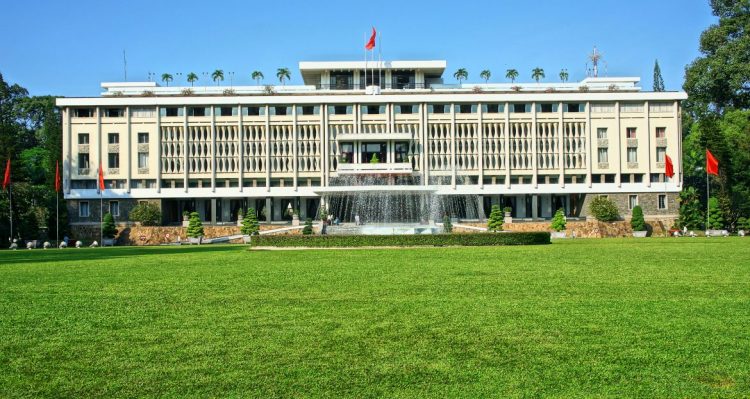
Source: Lux Travel DMC
The building was designed by Vietnamese architect Ngo Viet Thu; therefore, it breathes the eastern vibe via its every single detail, from the inside to the outside while still blending well with the western architectural style. The details of the palace shape like the Mandarin letters that represent different meanings.
3. Notre Dame Basilica – One of the typical Romanesque Saigon Buildings
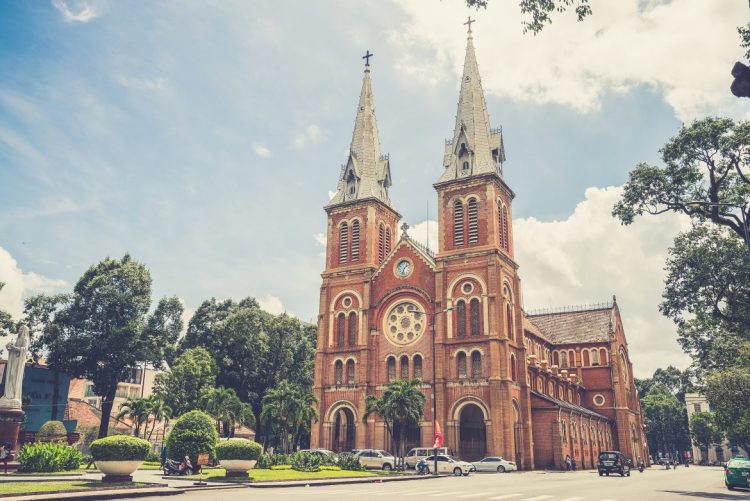
Source: Lux Travel DMC
Being built in 1880, the Notre Dame Basilica is the important worship place of a large Catholic Community in Saigon. To pay a visit to Notre Dame Basilica is always a must-do for any Saigon tours.
Influenced by the French civilization and Christianity styles, Notre Dame embodies the typical vibe of the 19th and 20th centuries with the harmony of Romanesque and Gothic styles. Notably, all the materials used to construct the church was imported from France. The most outstanding feature of Notre Dame Basilica is the 60-meter high twin towers which are inspired by France’s Notre Dame de Paris.
4. Saigon Central Post
Opposite to Notre Dame Basilica is the Central Post – another city’s landmark that bears the typical French colonial style.
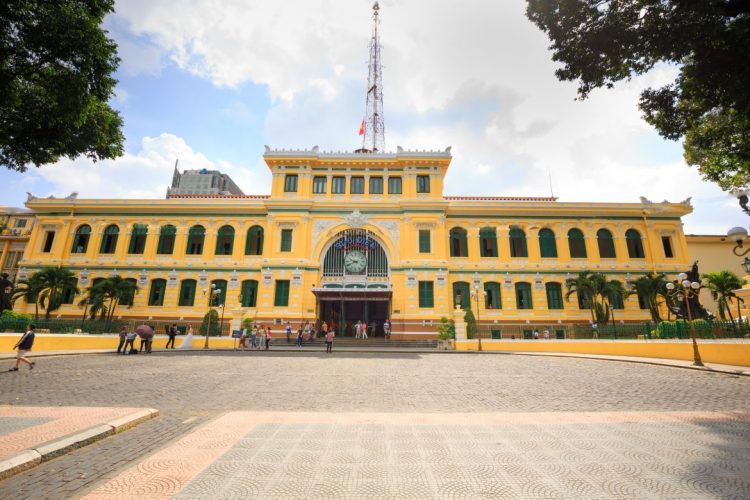
Source: Lux Travel DMC
Dating back to 1891, it is rumored to own credits to Gustave Eiffel – the world-famous French architect who designed the Eiffel Tower – the landmark of Paris and Long Bien Bridge in Hanoi. Saigon Central Post represents the perfect combination of different architectural styles, namely Gothic, Renaissance, and classical French vibe. Walking into the Central Post Office, visitors would feel like you are brought back to the 20th-century building in Europe rather than a post office in the East.
5. Ho Chi Minh City Museum (Gia Long Palace)
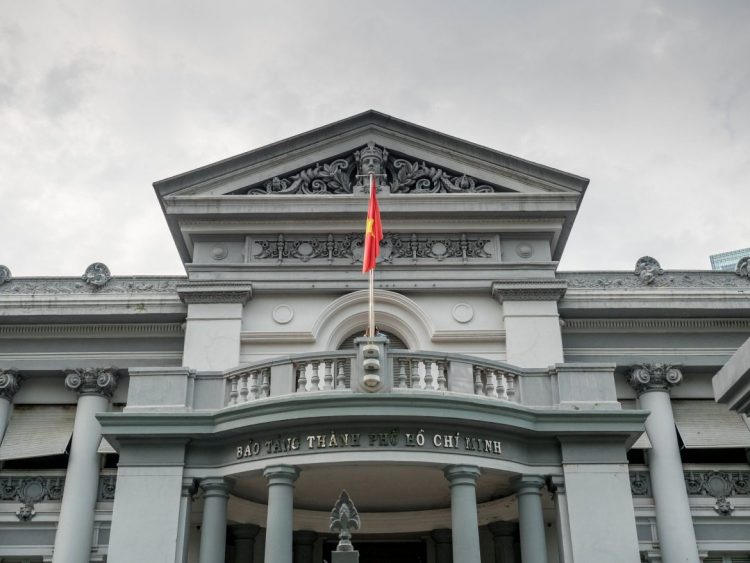
Source: Flickr – Stéphane DAMOUR
Gia Long Palace, which is now the city’s museum, is another typical French colonial architectural work to visit in Saigon. The palace was designed by Alfred Foulhoux – a famous French architect and completed in 1890. It was initially the Museum of Commercial Trade where South Vietnam’s goods and products were displayed. However, after decades of ups and downs in the 20th century, this building underwent several changes in names and purposes of use. Today, it houses the Ho Chi Minh City Museum that showcases the history of the city during the Vietnam War.
Inside the museum, there is a secret underground tunnel that South Vietnam’s President Ngo Dinh Diem built to become an escape route.
6. Ha Chuong Hoi Quan Pagoda – The Chinese Assembly
While other Saigon buildings refer to the influences of Western architecture, Ha Chuong Hoi Quan Pagoda is where you can feel the strong oriental vibe by the Chinese community. It was built by Chinese-Vietnamese community who roots from Fujian and is dedicated to the Goddess of Seafarers.
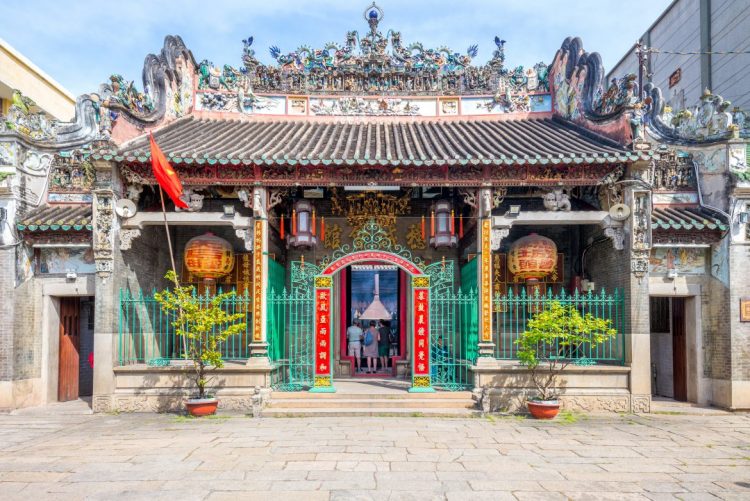
Source: Lux Travel DMC
The highlight of this Chinese Assembly is its 4 carved stone pillars. These dragon-wrapped stones were made in China and then delivered to Vietnam by boat. Additionally, the oriental ornaments also appear densely on the pagoda’s walls and roofs. Aside from its significant cultural and religious value, Ha Chuong Hoi Quan Pagoda has always been one of the most beautiful architectural works in Ho Chi Minh City.
7. Cafe Apartment at 42 Nguyen Hue

Source: Luxury Traval
Nestled alongside Nguyen Hue Walking Street is an impressive 9-story cafe apartment at No. 42. Before 1975, this is one of the Saigon buildings where many high-ranking Saigon government officials stayed. It also once served as the residence for the United States’ advisors and navy servants during the Vietnam War.
Nowadays, this apartment is home to different offices, co-working spaces, stores, and coffee shops. The cafe on this buildings offers a great view of the bustling Nguyen Hue Walking Street, where lots of cultural and entertainment events take place every weekend.
8. 14 Ton That Dam Cafe Apartment
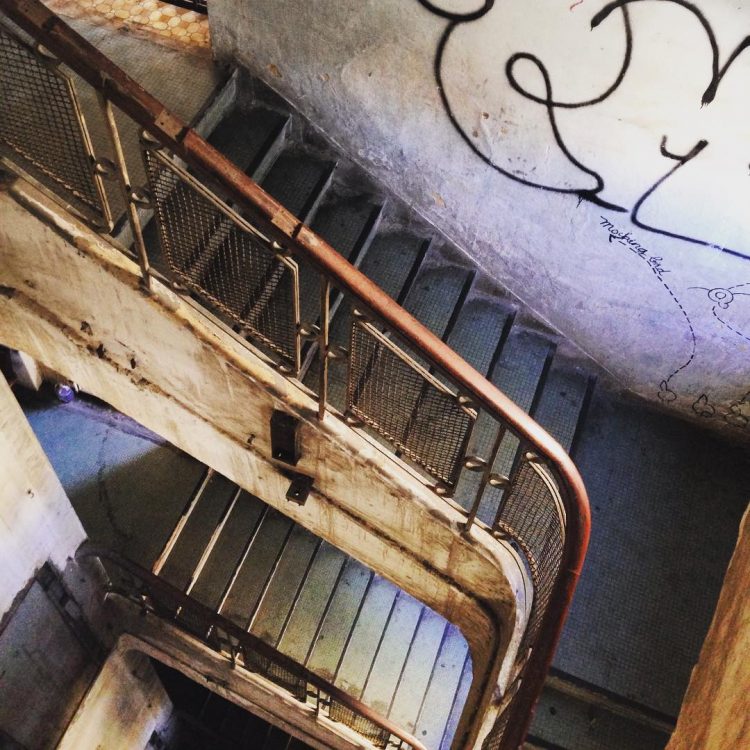
Source: Instagram @katjasinikka
Without knowing it in advance, you might have walked across 14 Ton That Dam without even thinking about entering this hidden world. Located in Saigon downtown, this is one of the most memorable buildings that you should visit.
Stepping into the dark, old entrance, you will penetrate a whole different world that houses a sprawling maze of corridors, exterior stairwells, mezzanine levels, home units, dark antechambers, and courtyards open to the bright, tropical sunshine. This French colonial-era place is now turned into a hip icon of Saigon youngsters with a number of cool cafes, hipster bars, fashion boutiques, and street food zones.
IV. To Wrap Up
The architecture and the bustling life on the streets have comprised the spectacular landscapes of Saigon that have allured travelers worldwide. By looking at Saigon buildings, tourists will be able to learn about the city’s development throughout history. If you have the chance to visit the Pearl of the Far East, don’t forget to spend some time witnessing the special architecture of these significant buildings and skyscrapers.
Want to plant a tailor-made Saigon trip that is similar to none? Contact Lux Travel DMC. As a leading luxury tour operator in Vietnam, we are confident that we could offer you a one-of-a-kind itinerary that will leave you with unforgettably pleasing experiences.
Let Lux Travel DMC accompany you on your upcoming Vietnam trip. Don’t hesitate to drop us a line at any time if you want our support.
Contact Us
- Address: No.456 Lac Long Quan Street, Tay Ho District, Hanoi, Vietnam
- Phone: (+84) 4 3927 4120
- Email: sales@luxtraveldmc.com
- Hotline: +84-336-276-996
- Website: https://luxtraveldmc.com
